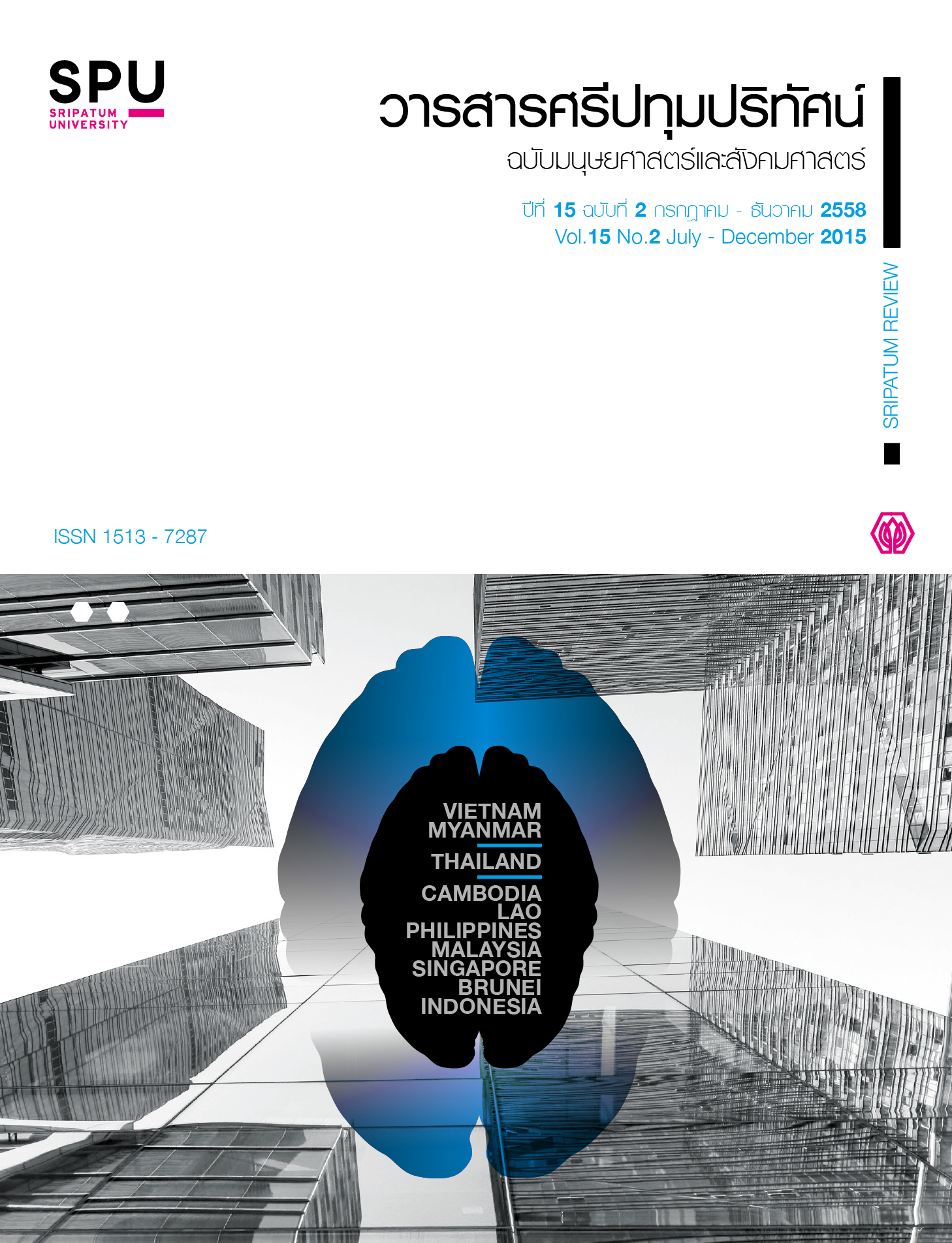THE FACTORS AND GUIDELINES OF CONDUCTING QUALITY ASSURANCE HAPPILY OF LECTURERS IN PRIVATE HIGHER EDUCATION INSTITUTIONS
Main Article Content
Abstract
This research was conducted by using a mixed-methods research design. Its three main objectives were (1) to synthesize the items indicating the happiness of conducting quality assurance (QA) of lecturers in private higher education institutions (HEIs), (2) to analyze the factors of happiness of conducting quality assurance of lecturers in the private HEIs, and (3) to propose the guidelines for conducting quality assurance happily for the private HEIs in Thailand. The research sample consisted of 16 chairmen of internal and external assessors at the higher education level, and 477 lecturers in the private HEIs. Three types of research instruments were employed: (1) a document synthesis note taking form, (2) an in-depth interview form, and (3) a questionnaire. The data collection and analysis were divided into three phases, namely, Phase 1: Item Synthesis, with application of content analysis; Phase 2: Factor Analysis, with application of descriptive statistics and second order confirmatory factor analysis using LISREL version 8.80; and Phase 3: Guidelines Proposal, with application of content analysis. The research findings were as follows: (1) 135 items indicating the happiness of conducting quality assurance were identified and they were grouped into five factors with 14 indicators, namely, Factor 1:The Institution Factor comprising three indicators; Factor 2: The Administrator Factor comprising two indicators; Factor 3: Quality Assurance Team Factor comprising three indicators; Factor 4: The Lecturers Factor comprising four indicators; Factor 5: The Assessor Factor comprising two indicators; (2) the second order confirmatory factor analysis model of the happiness of conducting QA of the lecturers in the private HEIs was found to be in accord with empirical data with the Chi-Square (χ2) of 44.80, df = 33, p = 0.083, RMSEA = 0.027, GFI = 0.99, and AGFI = 0.96, and (3) the five guidelines for conducting QA happily for the private HEIs were proposed with 19 practical methods.
Article Details
1. กองบรรณาธิการสงวนสิทธิ์ในการพิจารณาและตัดสินการตีพิมพ์บทความในวารสาร
2. บทความทุกเรื่องจะได้รับการตรวจสอบทางวิชาการโดยผู้ทรงคุณวุฒิ แต่ข้อความและเนื้อหาในบทความที่ตีพิมพ์เป็นความรับผิดชอบของผู้เขียนแต่เพียงผู้เดียว มิใช่ความคิดเห็นและความรับผิดชอบของมหาวิทยาลัยศรีปทุม
3. การคัดลอกอ้างอิงต้องดำเนินการตามการปฏิบัติในหมู่นักวิชาการโดยทั่วไป และสอดคล้องกับกฎหมายที่เกี่ยวข้อง
References
กระทรวงศึกษาธิการ. 2552. ประกาศกระทรวงศึกษาธิการ เรื่อง กรอบมาตรฐานคุณวุฒิระดับอุดมศึกษาแห่งชาติ พ.ศ. 2552(2 กรกฎาคม พ.ศ. 2552). กรุงเทพฯ: กระทรวงศึกษาธิการ.
กระทรวงศึกษาธิการ. 2549. ประกาศกระทรวงศึกษาธิการ เรื่อง กรอบมาตรฐานการอุดมศึกษา (7 สิงหาคม พ.ศ. 2549). กรุงเทพฯ: กระทรวงศึกษาธิการ.
กระทรวงศึกษาธิการ. 2545. พระราชบัญญัติการศึกษาแห่งชาติ พ.ศ. 2542 และที่แก้ไขเพิ่มเติม (ฉบับที่ 2) พ.ศ. 2545. กรุงเทพฯ: โรงพิมพ์คุรุสภาลาดพร้าว.
กัลยารัตน์ อ๋องคณา. 2549. “ความสัมพันธ์ระหว่างปัจจัยส่วนบุคคล การรับรู้คุณค่าในตนเอง สภาพแวดล้อมในงาน กับความสุขในการทางานของพยาบาลประจาการโรงพยาบาลเอกชน เขตกรุงเทพมหานคร.” วิทยานิพนธ์ปริญญามหาบัณฑิต จุฬาลงกรณ์มหาวิทยาลัย.
คมศร วงษ์รักษา. รองผู้อำนวยการ สำนักงานรับรองมาตรฐานและประเมินคุณภาพการศึกษา (องค์การมหาชน). สัมภาษณ์, 1 มิถุนายน 2556.
นงลักษณ์ วิรัชชัย. 2542. โมเดลลิสเรล: สถิติวิเคราะห์สำหรับการวิจัย. กรุงเทพฯ: จุฬาลงกรณ์มหาวิทยาลัย.
วิจิตร ศรีสอ้าน. 2558. “วัฒนธรรมการประกันคุณภาพ: คู่คิดหรือคู่แข่ง.” จดหมายข่าวธรรมาภิบาลมหาวิทยาลัย, 6 (1), 19-20.
ศูนย์เครือข่ายวิชาการเพื่อสังเกตการณ์และวิจัยความสุขชุมชน มหาวิทยาลัยอัสสัมชัญ. 2551. ประเมินความสุขของคนทำงาน (Happiness at Workplace): กรณีศึกษาประชาชนอายุ 18 - 60 ปีที่ทำงานในสถานประกอบการและองค์กรธุรกิจในเขตกรุงเทพมหานคร. มหาวิทยาลัยอัสสัมชัญ.
สำนักงานกองทุนสนับสนุนการสร้างเสริมสุขภาพ (สสส.). 2552. สู่องค์กรความสุข ยุควิกฤตคิดสร้างสรรค์ จัดการแบบมีทางเลือก. สืบค้นวันที่ 5 พฤษภาคม 2556.
สำนักงานคณะกรรมการการอุดมศึกษา. 2555. แผนพัฒนาการศึกษาระดับอุดมศึกษา ฉบับที่ 11 (พ.ศ. 2555-2559). กรุงเทพฯ: สกอ.
สำนักงานคณะกรรมการการอุดมศึกษา. 2550. กรอบแผนอุดมศึกษาระยะยาว 15 ปี ฉบับที่ 2 (พ.ศ. 2551-2565) (30 กันยายน 2550). กรุงเทพฯ: สกอ.
สำนักงานรับรองมาตรฐานและประเมินคุณภาพการศึกษา (องค์การมหาชน). 2552. สถานการณ์การประเมินคุณภาพภายนอกรอบสอง เสนอต่อคณะกรรมการการอุดมศึกษา วันพุธที่ 4 กุมภาพันธ์ พ.ศ. 2552. กรุงเทพฯ: สมศ.
สุบิน ยุระรัช. 2553ก. “การสังเคราะห์งานวิจัยเกี่ยวกับแนวปฏิบัติที่ดีในการใช้ผลประเมินคุณภาพภายในและภายนอกของสถาบันอุดมศึกษา.” วารสารสมาคมส่งเสริมการวิจัย, 1 (1), 63-71.
สุบิน ยุระรัช. 2553ข. “การวิเคราะห์สาเหตุของการไม่ใช้ประโยชน์และการนำผลประเมินคุณภาพไปใช้ประโยชน์อย่างคลาดเคลื่อนในสถาบันอุดมศึกษา.” รายงานสืบเนื่องการประชุมทางวิชาการและเสนอผลงานวิจัยสร้างสรรค์: ศิลปากรวิจัยครั้งที่ 3. ระหว่างวันที่ 28-29 มกราคม 2553 ณ มหาวิทยาลัยศิลปากร วิทยาเขตพระราชวังสนามจันทร์, 363-369.
สุบิน ยุระรัช. 2552. รายงานการสังเคราะห์แนวปฏิบัติที่ดีของการทำประกันคุณภาพในสถาบันอุดมศึกษา. กรุงเทพฯ: มหาวิทยาลัยศรีปทุม. (อัดสำเนา).
อรุณวดี คุ้มสิริพิทักษ์. 2545. “การเสริมสร้างอานาจในงานกับความพึงพอใจในงาน ของพนักงานในโรงงานอุตสาหกรรม.” วิทยานิพนธ์ปริญญามหาบัณฑิต มหาวิทยาลัยเกษตรศาสตร์.
Al-Alawi, Y., Al-Kaabi, D., Rashdan, S. & Al-Khaleefa, L. 2009. “Quality assurance and continuous improvement: a case study of the University of Bahrain.” Quality in Higher Education, 15 (1), 61-69.
Bazargan, A. 2007. “Problems of Organising and Reporting Internal and External Evaluation in Developing Countries: The Case of Iran.” Quality in Higher Education, 13 (3), 207-214.
Bernhard, A. 2010. “Two European responses to assure quality in higher education.” Problems of Education in the 21st Century, 20, 36-43.
Brown, J. F. & Marshall, B. L. 2008. “Continuous quality improvement: an effective strategy for improvement of program outcomes in a higher education setting.” Quality Improvement, 29 (4), 205-211.
Chantarasombat, C. 2009. “Model a Knowledge Management for Educational Quality Assurance in Faculty of Education, Mahasarakham University in Thailand.” European Journal of Social Sciences, 11 (3), 428-440.
Cheung, P. & Tsui, C. 2010. “Quality assurance for all.” Quality in Higher Education, 16 (2), 169-171.
Creswell, J. W. 2005. Educational Research: Planning, Conducting, and Evaluating Quantitative and Qualitative Research. 2nd Ed. Upper Saddle River, New Jersey: Pearson Education.
Creswell, J.W., & Plano Clark, V.L. 2007. Designing and conducting mixed methods research. Thousand Oaks: Sage.
Diener E. 2000. Subjective Well-Being: The Science of Happiness and a Proposal for a National Index. American Psychologist. 55 (1), 34-43.
Hair, J.F., Anderson, R.E., Tatham, R.L., & Black, W. C. 1998. Multivariate data analysis (5th edition). Upper Saddle River, NJ: Prentice Hall.
Jöreskog, K.G. & Sorbom, D. 1993. LISREL 8: User’s Reference Guide. Chicago: Scientific Software International.
Manion, J. 2003. Joy at Work: As Experienced, As Expressed. Doctor of Philosophy in Human and Organizational Systems. University of Michigan.
Martin, M. 2009. “On the Relationship of External Quality Assurance and Equity: Can the Converge on National Policy Agendas?.” Quality in Higher Education, 15 (3), 251-262.
Meade, P., Morgan, M. & Health, H. 1999. “Equipping leaders to capitalise on the outcomes of quality assessment in higher education.” Assessment & Evaluation in Higher Education, 24 (2), 147-156.
Rego, A. & Cunha. 2008. Workplace spirituality and organizational commitment: An empirical study. Journal of Organizational Change Management, 21 (1), 53-75.
Rosa, M.J., Tavares, D. & Amaral, A. 2006. “Institutional Consequences of Quality Assessment.” Quality in Higher Education, 12 (2), 145-159.
Stenphenson, P. 2009. The Evidence for Continuous Quality Improvement: A Literature Review. The Royal Australian College of General Practitioners (Prepared for the QA & CPD Sub-Committee).
Stevens, J. 1996. Applied multivariate statistics for the social sciences. 3nd ed. New Jersey: Lawrence Erlbaum Associate Publisher.
Warr, P. 2007. Work, Happiness, and Unhappiness. New Jersey: Lawrence Erlbaum Associates.


